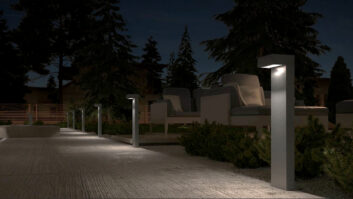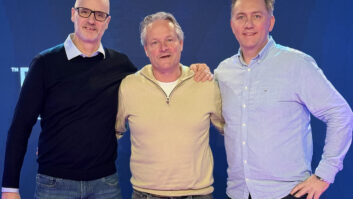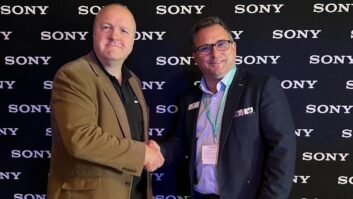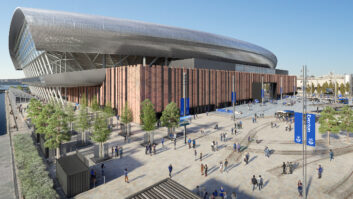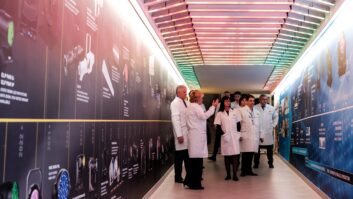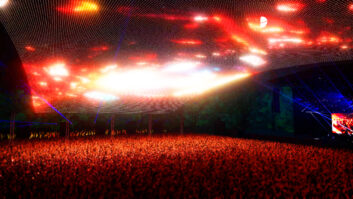For most outside the UK, the James Blunt phenomenon has probably passed them by. In the UK, however, the singer/songwriter and musician has attracted considerable attention largely because of his unusual background – educated at private schools, followed by a six year period in the British Army. He left the army in 2002, having risen to the rank of Captain and seen service in Kosovo. Since then, he has released three albums, the last of which debuted in the UK charts at number 4 with sales of 100,000 in the first week.
For Blunt’s “Some Kind of Trouble” (the title of his most recent album) 2011/12 world tour – which has just kicked off in Europe – a grandMA2 light was chosen by lighting designer Paul Normandale (whose credits include shows by The Chemical Brothers, Kings of Leon and The Scissor Sisters) and lighting director Glen Johnson (Will Young, Tracy Chapman, Crowded House). 2 x grandMA2 lights are on the tour, running in full tracking back up, with networking provided via 2 x MA NPU (Network Processing Unit).
@page_break@
Asked about how a lighting designer sets about designing a tour like this – does an assessment of technical feasibility follow the lighting design, or does the designer need to know what is technically feasible before starting the design process? – Noarmandale smiled. “As you might expect,” he said, “it’s a fluid line between what you know, what you think you know – and, mostly, what others know.”
The main reason that grandMA2 was chosen for this tour – apart from the fact that it is Johnson’s current console of choice – is that they are using the desk’s DMX merging facility to enable video content stored on a Catalyst media server to be run through 50 x Martin Professional MAC 101 LED moving lights and 24 x Sun Strip MR16 battens.
The grandMA2 takes in Art-Net from the Catalyst, allowing Johnson to merge four universes of DMX in the desk, and send colour and intensity information from the Catalyst out as standard DMX – via the MA NPU – to the 101 and Sun Strip. This allows these specific lights and six columns of Barco Stealth LED screens upstage to be perfectly pixel-mapped and run harmoniously from the same video triggers. The video content was specially created for the tour by film maker Julie Jacob.
@page_break@
The video mapping is currently programmed into six songs, and Johnson also has the option of bringing up the lights as a layer on the Catalyst and applying clips to the lights almost instantaneously on the fly. He can also control all the fixtures as conventional light sources via the desk. This function of the grandMA2 came with the first release of version 2.1 software, and could produce exactly the effects that Normandale wanted for certain elements of the show.
Apart from the DMX merging, Johnson likes numerous features of the grandMA2 architecture, and was one of the first lighting directors and programmers to take up the platform when it was launched in 2009.
“grandMA2 light is a small and lightweight working surface with an extremely neat footprint and everything is laid out exactly as you would wish,” said Johnson. “The syntax is so logical that you don’t even need to read the manual – it’s extremely straightforward to programme and run”, going on to admit that he has never had to consult a manual for anything he’s wanted to do on a grandMA2.
@page_break@
Johnson has worked with lighting director Paul Normandale over the past six years. He notes that the biggest difference between the current James Blunt tour and previous ones is the level of video integration in the lighting, with moving lights being mapped to the video. “While this shouldn’t be complicated,” he said, “it does involve a few days of head scratching, reading and phone calls. And then, suddenly, it becomes clear and you think “well, that was easy”.”
For this tour, according to Johnson, the biggest challenge was the six days spent visualising the show, with no physical lights – and then having just one day on site before the opening of the show and the start of the world tour. The show features 96 moving lights and 240 dimmers.
On tour, a specific challenge is what Johnson describes as “the dreaded white room or roof”. “I have separate overrides on all fixtures so I can limit their output to handle this,” said Johnson. “Lights bouncing all over the place would be a nightmare to try and program for each room, so I limit the output as we go through the show, depending on the colours and looks I need to create to keep to Paul’s design concept.”
According to Johnson, the majority of the venues included in the tour are not too difficult. “The rig is consistently the same,” he said, “and it’s only when you go to far off places like China, South America and South Korea – and even, strangely, to the USA where venues are smaller – that you need to start thinking on your feet and go back to the original lighting design concept.”
Picture credits: Paul Normandale, Judy Jacob
